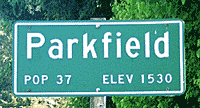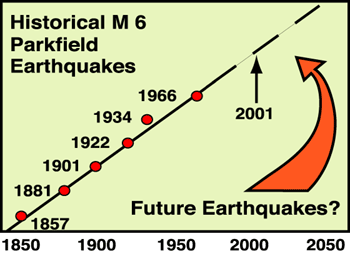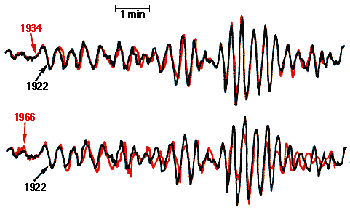

You are viewing an archived web page that is no longer maintained. View current CISN web pages

|
| Current Parkfield town sign. photo by Jennifer Adleman, USGS. |
The Mw 6.0 earthquake on the San Andreas fault on 9/28/2004 at 10:17AM PDT fulfilled some, but not all elements of the original 1985 earthquake forecast for Parkfield (see the Parkfield Prediction Experiment for background on the scientific basis and seismic history of the region). The forecast was based on scientific studies published by Bakun and McEvilly ( 1979; 1984) and by Bakun and Lindh (1985). Their work showed that moderate-size earthquakes have occurred on the Parkfield section of the San Andreas Fault at fairly regular intervals - in 1857, 1881, 1901, 1922, 1934 and 1966. While some is known about the first three shocks, available data suggested that all six earthquakes were about M 6 and ruptured the San Andreas Fault at Parkfield. The similarity of teleseismic long period seismic waveform shapes and amplitudes for the 1922, 1934 and 1966 earthquakes suggested that each earthquake ruptured the same segment of the fault in a similar manner. Based on these and other data, Bakun and Lindh hypothesized that these earthquakes were characteristic in the sense that they repeatedly ruptured the same area on the fault in an earthquake of about M 6.

|
| Significant earthquakes have occurred on the Parkfield section of the San Andreas fault at fairly regular intervals - in 1857, 1881, 1901, 1922, 1934, 1966 and now 2004! |
Analysis of the aftershocks and rupture models of the 2004 Parkfield indicates that it ruptured along the same section of the fault in an earthquake of similar magnitude to the earlier members of the Parkfield earthquake series. Unlike the 1922, 1934 and 1966 shocks which ruptured from northwest to southeast, the 2004 quake initiated at the southeast end and ruptured to the northwest. Also, the 1934 and 1966 quakes were immediately preceded (by 17 minutes, respectively) by the same characteristic M 5 foreshock, while there was no foreshock activity (M > 0) for the 2004 earthquake. Research is now underway to better understand the relationship of the 2004 rupture to the earlier earthquakes.
The approximately regular cycle of the M6 earthquakes led Bakun and Lindh (1985) to forecast that another M 6 earthquake would rupture the same segment of the San Andreas Fault at Parkfield within 5 years of 1988. This "Long-Term Prediction" was evaluated and endorsed by the National Earthquake Prediction Evaluation Council in 1985, and the State of California was notified by the USGS that there was a high probability of about M 6 earthquake in the Parkfield region in the 1985-1993 interval. The year 1993 came and went without an earthquake, and thus the temporal element of this long-term prediction clearly failed.

|
| Recordings of the east-west component of motion made by Galitzin instruments at DeBilt, the Netherlands. Recordings from the 1922 earthquake (shown in black) and the 1934 and 1966 events at Parkfield (shown in red) are strikingly similar, suggesting virtually identical ruptures. |
In formulating their temporal forecast, Bakun and Lindh hypothesized that the 1934 earthquake had come early, having been triggered by a nearby M 5 event, but the 1966 earthquake put the process back onto a regular cycle. The narrow temporal window for their long-term prediction is a direct consequence of this hypothesis. Since then, considerable work has been done by others to investigate the regularity of earthquake recurrence intervals of characteristic earthquakes. For some characteristic earthquake sources, the intervals are very regular, varying by only a few percent from cycle to cycle. More typical are less well-behaved sequences for which the irregularity (as expressed as the standard deviation of the intervals divided by the mean interval) falls in the range from 0.3 to 0.7. Applying the methods used in the most recent report on long-term earthquake forecasts in California, the now 7 known Parkfield earthquakes have an "aperiodicity" value of 0.44. Thus, while the Parkfield 2004 earthquake was not late according to current models, accurately forecasting the time of damaging earthquakes remains as a significant challenge.